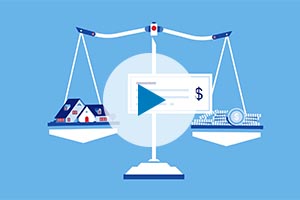
Co-signing 101: Applying for a loan with co-borrower

Tips for realtors to help clients get their homeownership goals back on track

What are conforming loan limits, and why are they increasing?
Expert insights on how loan limits affect the housing market and why they changed for 2024.
Prospective homebuyers in 2023 faced another challenging year of increasing home prices, rising mortgage rates and decreasing inventory. If you’ve been paying attention to the real estate market, you’ve probably heard about the recent adjustment to conforming loan limits. U.S. Bank offers perspective on why this occurred. Read on to learn what conforming loan limits are and how they impact the housing market.
Conventional versus jumbo mortgages
Conforming loan limits, at their core, are used to separate conventional loans from jumbo loans. Fannie Mae and Freddie Mac, sometimes referred to as government sponsored enterprises (GSEs), set requirements like down payments, minimum credit scores and documentation for mortgages they purchase. Additionally, the Federal Housing Finance Agency (FHFA), which regulates the GSEs, sets guidelines on maximum loan sizes (i.e., conforming loan limits) that qualify for purchase by Fannie Mae and Freddie Mac, helping them manage their risk when purchasing conventional mortgages from lenders.
Jumbo loans are mortgages that exceed these conforming loan limits. Unlike conventional mortgages, jumbo loans cannot be purchased by Fannie Mae and Freddie Mac. Instead, they generally must be maintained by the lender for the entire life of the loan. This puts increased risk on lenders and drives up interest rates for homebuyers.
Supporting homebuyers through the secondary mortgage market
Conventional mortgages are designed to benefit the average homebuyer, ensuring that the housing market is affordable for most people. Fannie Mae and Freddie Mac help make this possible by purchasing conventional mortgages from lenders. When a buyer takes out a home loan, lenders can sell the mortgage to Fannie Mae and Freddie Mac, who bundle numerous mortgages together to create securities. These securities are later sold on the secondary market.
GSEs take individual mortgage loans, buy them from lenders and then pool them – or package them together – into securities. There might be one security that has a thousand mortgages from all different parts of the country. Those thousand mortgages are sliced and diced into different tranches of risk that investors might want to buy.
When Fannie Mae and Freddie Mac buy a mortgage from a lender, they assume the associated risk and spread it between investors. If a homeowner defaults on their mortgage, the impact for lenders is significantly minimized because they've already sold off the mortgage to Fannie Mae and Freddie Mac. In turn, lenders are more likely to reduce interest rates.
Investors purchasing mortgage-backed securities benefit from the pooling together and repackaging of mortgages while also being guaranteed against the risk of homeowner default by Fannie Mae and Freddie Mac. Meanwhile, the GSEs benefit from the scale and diversification that makes the impact of a single mortgage default like a drop in the bucket compared to the more than $6 trillion of combined mortgage portfolios between both companies.
GSEs help make mortgages more accessible and affordable for borrowers by pooling risk and selling securities to investors, and they pull in additional investment money into the mortgage market, which helps make that happen.
Loan limits increase for 2024
Every November, the FHFA adjusts the conforming loan limits to reflect changes in the housing market. This helps ensure the average homebuyer can still get a conventional mortgage, even as housing costs rise. The FHFA recently announced that the baseline conforming loan limit for 2024 will be $766,550 for one-unit properties, an increase of $40,350 from 2023. In designated high-cost areas, the new ceiling loan limit for one-unit properties will be $1,149,825, which is 150% of $766,550.
FHA loan limits
As another key player in the housing market, the Federal Housing Administration (FHA) is required by statute to follow the example of the FHFA when setting loan limits for low-income and first-time homebuyers. Not surprisingly, they announced similar adjustments to their maximum loan limits this November.
Get more insights from a U.S. Bank mortgage loan officer about changes in the housing market.
Related content


